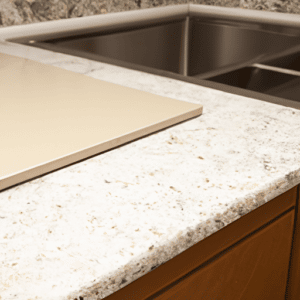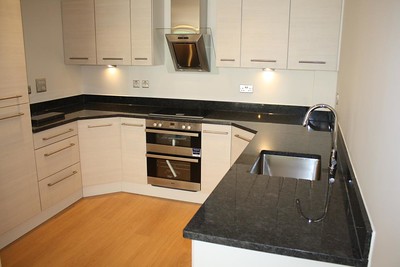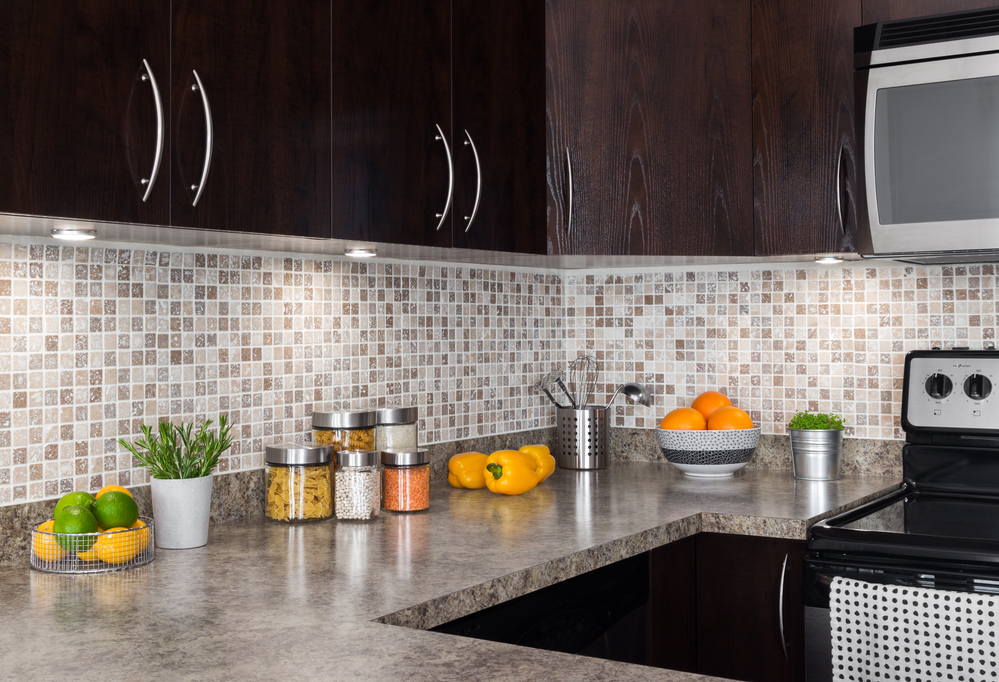While you’re probably familiar with solid wood, stone or laminate worktops, you might not have heard about the versatile alternative material that is composite.
We’re going to answer “what is a composite worktop” by elucidating that it is a practical alternative to natural products.
This article will take you through all the advantages of a composite worktop and demonstrate how it could be the ideal choice for your new kitchen worktop.
What Are Composite Kitchen Worktops Made Of?

Composite worktops are made by combining two or more materials to produce an engineered product with improved characteristics.
They offer one of the best combinations of essential features like affordability, durability, heat and liquid resistance, ease of maintenance, and the look, feel, and appeal of natural products.
Most composite kitchen worktops are made from a polymer resin mixed with minerals, colour pigments and binding agents. The material is rolled into solid sheets between 3 and 5mm thick and bonded onto a medium-density fibreboard (MDF) or chipboard base. The underside has a 1mm laminate attached to stop moisture from entering. Edging strips are fitted so the sides are sealed and match the top.
The minerals blended into the material will determine its colour and appearance. Depending on the finished requirement, you’ll commonly find quartz crystals and acrylic materials.
What Are the Benefits of Composite Worktops?
Compared to other materials, composite worktops have a large number of benefits.
Highly Economic
Compared to natural materials, composite worktops are usually much cheaper. For example, a composite stone worktop will be considerably more affordable than a real one.
Heat Resistance
Composite worktops, including composite quartz worktops, have superior heat-resistant properties that can handle up to 240°C.
Scratch and Impact Resistance
Composite worktops also have excellent properties when it comes to scratches or impacts. While it’s still a good idea to use a chopping board, you don’t have to worry about everyday wear and tear. Composite granite worktops are as strong or stronger than the real thing.
Water-Resistant
Spilt liquids are another thing you don’t have to be concerned about. Composite worktops are entirely non-porous. This means that, for example, liquids or any kind can’t stain composite marble worktops as they might with natural material.
Hygienic
Because they’re non-porous, composite worktops are incredibly hygienic, so germs, mould and bacteria have no place to hide.
Easy to Maintain
All you need to clean a composite worktop is a soft cloth, sponge or brush, and some warm soapy water or kitchen degreaser. Compared to natural materials, such as stone worktops, composite worktops are almost a pleasure to keep clean.
Won’t Fade
Unlike lesser materials, the colour of composite worktops won’t fade. The blend includes chemicals to resist the effects of UV light, so you don’t need to worry about your surfaces losing their brilliance.
Warm to the Touch
Unlike some natural materials, composite materials are warm to the touch. This can make them much more comfortable to use than stone worktops, such as for a breakfast bar or other surfaces to eat from.
Easy to Install
Composite materials are as easy to install as laminate worktops. They can be moulded into curved shapes or fitted with seamless joints for uninterrupted lines.
Repairable
It’s even possible to repair a composite worktop if you manage to damage it. Scratches can be sanded and polished to bring the surface back to its normal look.
Wide Range of Colours and Finishes
Unlike natural materials, where you are ultimately limited in what is available, composites come in a vast range of finishes. In addition to stone, marble or granite, you can choose from different colours and even designs with glass or mirrored chips added to the material.
Whatever look you’re seeking for your kitchen, composites can likely achieve it.
Long Warranties
It’s common for the manufacturers of composite worktops to offer confidence-inspiring warranties of at least ten years and as long as 25 or more.
Is a Solid Surface Worktop Different From a Composite Worktop?

A solid surface is different because it doesn’t have a fibreboard sub-frame. Instead, the composite material is formed in sheets about 25-30mm thick and represents the entirety of a solid surface worktop.
Solid surface worktops have all the same benefits as composites. They also are easy to use when a lot of cutting needs to be made, as they do not require any edging strips.
Solid surfaces are excellent to use with under-mounted sinks. Additionally, in high moisture environments such as bathrooms, they are a good choice because there is no chance of moisture ever penetrating the edges or underside.
Do Composite Worktops Suit All Styles of Kitchen?
Now that we’ve explained what is a composite worktop you might wonder if they will fit with your planned kitchen style.
The most popular kitchen type to use composite worktops is modern or contemporary. However, you can also use them in traditional or shaker kitchens thanks to the wide range available.
Choose Your Composite Worktop Material
As we’ve looked at what is a composite worktop, we’ve seen that they’re one of the most versatile and practical material choices.
By combining several materials, composite worktops are a surface that is easy to clean, scratch, water and heat-resistant, and come in a wide range of colours and designs.
Choosing a composite material can give you almost perfect worktops, and thanks to their durability, you’ll be enjoying them for many years to come.

